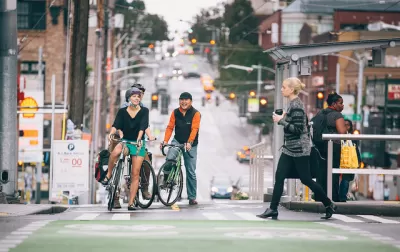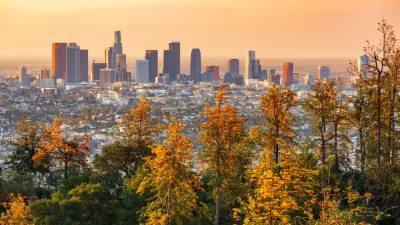The city of Seattle is working on a plan to create a zero-emissions zone to mitigate urban pollution and reduce carbon emissions in dense, congested parts of the city.

In order to meet its commitment to the C40 Fossil-Fuel-Free Streets Declaration, Seattle has released a memo draft that outlines the city's plan to implement an emissions-free zone, reports Ryan Packer for The Urbanist.
While many details of the proposal are redacted, the memo mentions two strategies that the city plans to implement, says Packer: "utilizing street space in commercial business districts (like with the Ballard Avenue cafe street or The Patio common restaurant seating area in Columbia City) and designating residential streets local-access-only with the Stay Healthy Streets program and the Home Zone pilots programs."
Seattle first signed on to the C40 pledge in 2017, one of 12 cities to do so at the time. Strategies employed by other cities include cordon pricing for vehicles entering central zones, pedestrianizing streets, and improving bike and pedestrian infrastructure. On its website, the C40 calls low-emission zones (LEZs) "a way for cities to take ambitious action more quickly in a priority area," letting cities expand the programs as results become apparent.
Planetizen has previously covered plans for zero-emissions neighborhoods in Santa Monica, where a designated zero-emissions delivery zone gives priority access to clean vehicles, and Bergen, which plans to transform a former shipping district to a 'regenerative' car-free zone that relies on low-impact mobility and access to the city's public transit system.
FULL STORY: Four Years Later, Seattle Emissions-Free Area Has Gone From Promise to Draft Plan

Study: Maui’s Plan to Convert Vacation Rentals to Long-Term Housing Could Cause Nearly $1 Billion Economic Loss
The plan would reduce visitor accommodation by 25,% resulting in 1,900 jobs lost.

Alabama: Trump Terminates Settlements for Black Communities Harmed By Raw Sewage
Trump deemed the landmark civil rights agreement “illegal DEI and environmental justice policy.”

North Texas Transit Leaders Tout Benefits of TOD for Growing Region
At a summit focused on transit-oriented development, policymakers discussed how North Texas’ expanded light rail system can serve as a tool for economic growth.

Nevada Bills Aim to Establish Home Insurance Assurance Amidst Wildfire Risk
Republican sponsor hopes the FAIR plan would be “a true market of last resort.”

Virginia Law Allows Judges to Mandate Speed Limiters
The law could set a new precedent for speed limiting tech on U.S. vehicles.

Comment: EPA Cuts will Send Atlanta Back to Eye-burning Ozone, Lung-damaging Smog, and Raw Sewage in the Chattahoochee River
A veteran political journalist takes stock of the hard-earned ground Georgia stands to lose with slashed environmental protection.
Urban Design for Planners 1: Software Tools
This six-course series explores essential urban design concepts using open source software and equips planners with the tools they need to participate fully in the urban design process.
Planning for Universal Design
Learn the tools for implementing Universal Design in planning regulations.
City of Santa Clarita
Ascent Environmental
Institute for Housing and Urban Development Studies (IHS)
City of Grandview
Harvard GSD Executive Education
Toledo-Lucas County Plan Commissions
Salt Lake City
NYU Wagner Graduate School of Public Service





























